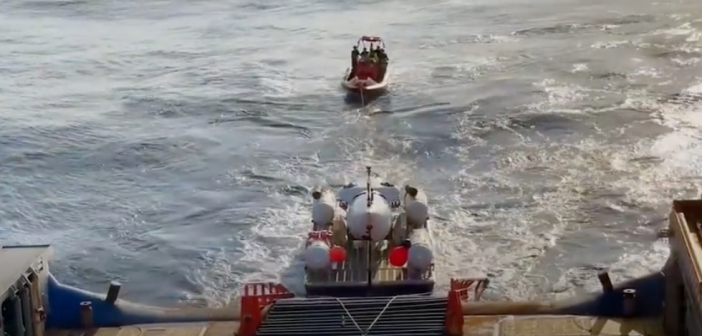On Sunday, June 18, the five men who were going to board the 22-foot submersible Titan gathered for a last-minute briefing on the Polar Prince, the sub’s mothership, at 5 a.m. The mood was serious. For three of the five, this was going to be their first dive on the Titan as it descended 12,500 feet down to explore the historic wreck of the Titanic.
The three had been told to stick to a low-residue diet the day before, and not to drink coffee that morning. There was no head on the Titan; the men could use a bottle or duck behind a blanket in the back of the sub if necessary. They also were told not to expect to see anything on the two-and-a half-hour trip down to the Titanic because the sub’s floodlights would be turned off to save battery power. The only light inside the sub would come from computer screens or pens equipped with little bulbs, for the same reason.
Christine Dawood looked on as her husband, Shahzada, 48, a wealthy British-Pakistani businessman, and her son, Suleman, 19, put on their orange jackets, gloves, helmets and boots and were loaded with the others on a raft that took them to the floating platform behind the ship that would actually launch the Titan. They were far from shore; the nearest land, St. John’s, Newfoundland, was about 400 miles away.
Years before, the Dawoods had become fascinated with the story of the Titanic, and in 2019 they signed up with OceanGate, the company organizing the dives, for two reservations at the going price of $250,000 each. Christine was going to go with the husband. Suleman was too young to go then; the minimum age was 18.
But the pandemic put off the dives for a while; the first time they could go was this June. Christine gave up her place to Suleman, now 19; after all, it was Father’s Day, and he could celebrate with his father on the ocean floor. Suleman took a Rubik’s cube with him, he wanted to solve it next to the Titanic, which sank in 1912 after hitting an iceberg. Some 1,500 passengers perished.
Back on the Polar Prince, Christine and her daughter, Alina, 17, watched as the men boarded the Titan with some difficulty. Climbing through the hatch was awkward, and the sub was cramped inside. There were no seats. Everyone on board sat on the floor with their backs leaning against the curved wall of the sub. There were two handles overhead to hang on to, and a 21-inch porthole in front.
Stockton Rush, 61, the CEO of OceanGate, served as the pilot, sitting in the back of the sub, using a PlayStation computer-game control to operate it.
Paul-Henry Nargeolet, 77, a French explorer who had made more than 35 dives to the Titanic, basically served as the guide. He had been working with OceanGate for at least a year.
The fifth person was Hamish Harding, 58, a British explorer and founder of a private equity firm. He previously had flown in space on Jeff Bezos’ Blue Origin rocket. This was his first trip on the Titan.
After all five men were on board the sub, OceanGate workers closed the hatch and tightened all the bolts. That was the only entrance/exit to the sub, and it could not be opened from the inside. Then they released the sub from its platform, and it slid underwater.
About one hour and 45 minutes later, Christine Dawood heard someone on the Polar Prince say that communications with the sub had been lost. That was not particularly unusual; it often happened at one point or another on previous dives. The only way to communicate was by coded text message. OceanGate’s procedure was that if communications were lost for more than an hour, the dive would be aborted and the sub would surface.
At about this same time, the U.S. Navy heard the sounds of an explosion, or submarine implosion, near the location of the Titanic on its super-secret sonar devices, built to listen to enemy submarines. (It later passed this information on to the U.S. Coast Guard.)
On board the Polar Prince, the hours ticked by, with nothing from the Titan. Christine Dawood kept staring at the ocean, hoping to see the sub on the surface. At first, she told the BBC, “We all thought they are just going to come up. We kept looking at the surface.”
In the past, more Titan missions were aborted than completed. None of the first four planned for this year got close to the Titanic because of rough weather in May and June. One dive lost a computer connection. On a dive last year, the sub started spinning in a circle near the Titanic because one of the four thrusters had been installed incorrectly.
As far back at 2018, OceanGate’s own staff and industry leaders warned about safety problems in the Titan’s design, carbon fiber construction and even the porthole, which some said was not capable of withstanding pressure at the Titanic’s depth. The company’s own director of marine operations said the Titan presented a “potential danger to passengers” at extreme depths; under questioning, he said “it’s a lemon.” (OceanGate subsequently fired him.) And a group of 30 industry leaders wrote a letter to Rush saying that OceanGate’s “experimental” approach could lead to a “catastrophic problem.”
Rush countered that the sub was safe and that he was a pioneer in the field; occasionally, he said, pioneers had to bend the rules.
After a four-day search covering an area twice the size of Connecticut, the Coast Guard announced that an unmanned remote vessel had found a debris field from the Titan about 1,600 feet off the bow of the Titanic. It was the result of “a catastrophic implosion” on the sub.
Last week, a Coast Guard cutter picked up some twisted pieces of that debris that the Canadian Coast Guard had taken to its base in Newfoundland. The Coast Guard is bringing them back to the U.S. for its investigation. The Coast Guard said the debris included human remains.
Read more at https://www.newyorker.com/news/a-reporter-at-large/the-titan-submersible-was-an-accident-waiting-to-happen and see OceanGate’s promotional video below:




